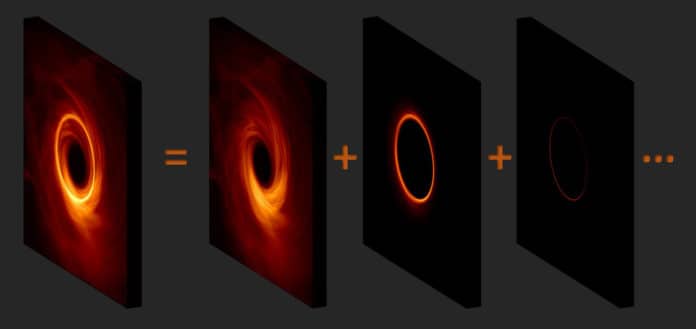Last year, in April, the Event Horizon Telescope (EHT) Collaboration had recently published images of the supermassive black hole in M87 using very long baseline interferometry (VLBI) at 1.3-mm wavelength. Recently, a group of scientists has distributed new calculations that foresee a striking and intricate substructure within black hole images from extreme gravitational light bending.
The image of a supermassive black hole in the galaxy M87 is dominated by a bright, unresolved ring. Each successive ring has about the same diameter but becomes increasingly sharper because its light orbited the black hole more times before reaching the observer. With the current EHT image, we’ve caught just a glimpse of the full complexity that should emerge in the image of any black hole.
Since black holes trap any photons that cross their event horizon, they cast a shadow on their bright surrounding emission from hot infalling gas. A “photon ring” encircles this shadow, delivered from light that is concentrated by the intense gravity close to the black hole. This photon ring conveys the fingerprint of the black hole—its size and shape encode the mass and rotation or spin of the black hole. With the EHT images, black hole specialists have a new tool to examine these extraordinary objects.
Daniel Kapec from the Institute for Advanced Study said, “This is a fascinating time to be thinking about the physics of black holes. Einstein’s theory of general relativity makes several striking predictions for the types of observations that are finally coming within reach, and I think we can look forward to lots of advances in the coming years. As a theorist, I find the rapid convergence between theory and experiment especially rewarding, and I hope we can continue to isolate and observe more universal predictions of general relativity as these experiments become more sensitive.”
George Wong, a physics graduate student at the University of Illinois at Urbana-Champaign, said, “Bringing together experts from different fields enabled us to connect a theoretical understanding of the photon ring to what is possible with observation.”
Wong developed software produce simulated black hole images at higher goals than had recently been computed and to disintegrate these into the predicted series of sub-images.
Scientists found that the black hole’s image substructure creates new possibilities to observe black holes.
Michael Johnson of the Center for Astrophysics, Harvard and Smithsonian (CfA), said, “What surprised us was that while the nested subrings are almost imperceptible to the naked eye on images—even perfect images—they are strong and clear signals for arrays of telescopes called interferometers. While capturing black hole images normally requires many distributed telescopes, the subrings are perfect for studying using only two telescopes that are very far apart. Adding one space telescope to the EHT would be enough.”
Alex Lupsasca from the Harvard Society of Fellows said, “Blackhole physics has always been a fascinating subject with deep theoretical implications, but now it has also become an experimental science. As a theorist, I am delighted to finally glean real data about these objects that we’ve been abstractly thinking about for so long.”
Journal Reference:
- Universal interferometric signatures of a black hole’s photon ring. DOI: 10.1126/sciadv.aaz1310.
